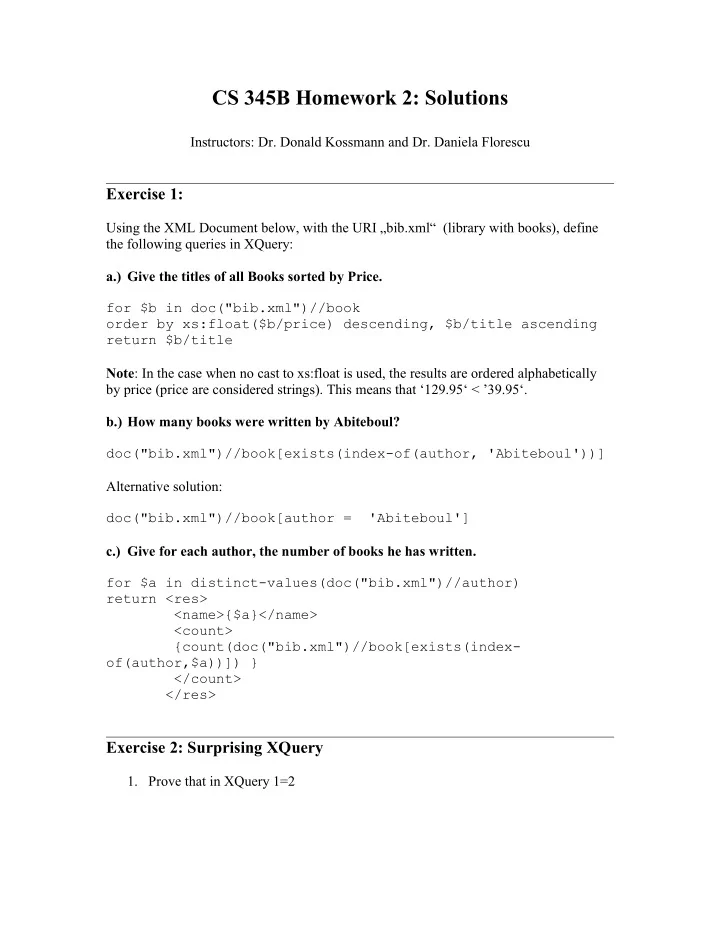

CS 345B Homework 2: Solutions Instructors: Dr. Donald Kossmann and Dr. Daniela Florescu Exercise 1: Using the XML Document below, with the URI „bib.xml“ (library with books), define the following queries in XQuery: a.) Give the titles of all Books sorted by Price. for $b in doc("bib.xml")//book order by xs:float($b/price) descending, $b/title ascending return $b/title Note : In the case when no cast to xs:float is used, the results are ordered alphabetically by price (price are considered strings). This means that ‘129.95‘ < ’39.95‘. b.) How many books were written by Abiteboul? doc("bib.xml")//book[exists(index-of(author, 'Abiteboul'))] Alternative solution: doc("bib.xml")//book[author = 'Abiteboul'] c.) Give for each author, the number of books he has written. for $a in distinct-values(doc("bib.xml")//author) return <res> <name>{$a}</name> <count> {count(doc("bib.xml")//book[exists(index- of(author,$a))]) } </count> </res> Exercise 2: Surprising XQuery 1. Prove that in XQuery 1=2
In XQuery the expression 1=2 will never evaluate as true. The two parts of the equality are promoted to the same type (numeric type) and in this case 1 can never be equal to two. This exercise wanted however to make you aware of the way XQuery uses “=” when sequences are involved. In particular, the following hold: 1 = (1,2) And 2 = (1,2). However, this just “might” let you think that 1=2. This is false , since “=” is not transitive. 2. Prove that if $x > $y and $y > $z, $x > $z is not necessarily true Example: $x := 2 $y := (1,4) $z := 3 Exercise 3: Consider an XML document corresponding to the model created for Exercise 1 (Exercise Sheet1).Write the XQuery expression for solving the folowing problems: 1. Give the list of the direct flights on the date of 2005-12-24 which have “North Pole” (airport name) as the source airport. <flights> { for $a in //Airport[name/text() eq 'North Pole'] return //Flight[(source eq $a/@airId) and (date/text() eq '2005-12- 24')] } </flights> 2. Retrieve the list of the busiest airports on the date of ’2005-12-24’ (based on the number of departures and arrivals). let $results := (<order> { for $a in //Airport let $c := count(//Flight[((./source/text() eq $a/@airId) or (./destination/text() eq $a/@airId))] ) order by $c descending, $a/name ascending return <result> {$a} <count>{$c}</count> </result> } </order>)
return $results/result[xs:integer(./count/text()) eq xs:integer(max($results//count/text()))] The idea of the solution is to: - first compute a list of airports with their ‚load count’ (number of arrivals and departures for that day). (let $results := ....) - second: retreive from the obtained result those who have a value for count which is equals to maximum value of count (return $results[... max ($results//count./text...)...]). 2.a) TO MAKE THIS MORE COMPLICATED, LET’S COMPUTE HOW BUSY AN AIRPORT IS BASED ON THE NUMBER OF PASSENGERS USING THE AIRPORT IN THAT DAY: (: Return the number of airports ordered by the number of passengers which fly through it (source or destination) on the day of '2006-12-24' :) (: compute for each passenger the list airports he is flyng in that day:) let $passengerVisits := for $p in //Passenger let $FlightIds := //Reservation[(passRef/text() eq $p/passportnumber/text()) and date="2005-12-24"]/flightRef (: the passenger's reservations for the day :) let $Flights := for $f in $FlightIds return //Flight[@flightId = $f] let $allVisitedAirports := $Flights/source/text() union $Flights/destination/text() (: all airports visited by the passenger :) return <visit> {$p} {for $a in $allVisitedAirports return <airp>{$a} </airp>} </visit> (: now we have a list of passengers, and for each we have a list of aiports. Now for each of those airports, we want to see how many times it appears in the list, for any passenger. :) for $a in distinct-values($passengerVisits//airp) let $numberOfPassengers := count($passengerVisits//airp[$a = . ]) order by $numberOfPassengers descending return <airport> <name>{$a}</name> <count>{$numberOfPassengers} </count> </airport> The solution works because here are the flights which have a reservation on that specific day, and the corresponding airports (source and destination). The number of passengers for each aiport is the count of appeareances of each airport in this results: Passenger 000111 LX123: LHR ZRH Passenger 000112 LX140: FFT NPL Passenger 000138 LX138: FFT PRG Passenger 000114 LX168: AMS SPL ------------------------------------------------------------------- => FFT (2), ZRH(1), NPL(1), PRG(1), AMS(1), SPL(1)
3. Identify all the flight destinations of the Passenger ‚Santa Claus’. for $p in //Passenger[name eq 'Santa Claus'], $r in //Reservation where $r/passRef eq $p/passportnumber return distinct-values(//Airport[@airId eq //Flight[$r/flightRef eq @flightId]/destination]/name) Notes: The solution is based on a JOIN between the Passengers and the Reservations, which binds a separate variable ($p and $r) to each type of element. The join is based on the condition: $r/passRef eq $p/passportnumber and retrieves all Reservations by the Passenger with the name ‚Santa Claus’. (in the reservation we have the flightId and we can retrieve the ) The final condition in the return clause: • retrieves the flight destination (airport id) corresponding to the flightId in the Reservations • retrieves the name of that specific aiport
Recommend
More recommend